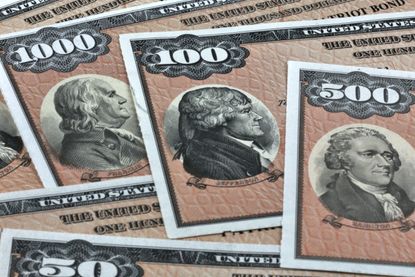Is It A Good Time To Cash In Your I Bonds?
As inflation eases, investors are redeeming their I bonds and putting the money elsewhere.


In 2022, a spike in inflation made normally staid Series I savings bonds almost as popular as tickets to Taylor Swift’s Eras tour. I bonds issued between May and October 2022 earned a six-month composite rate of 9.62%, creating a surge in demand from yield-hungry investors that briefly overwhelmed the TreasuryDirect website.
I bond rates have since come down to earth; bonds issued between May and October 2023 pay a composite rate of 4.3%. Meanwhile, some certificates of deposit and high-yield savings accounts are paying more than 5%, and the recent yield on one-year Treasury bills topped 5.3%. Yields on Treasury inflation-protected securities (TIPS) — government securities that are indexed to the rate of inflation — are also attractive now, says David Enna, founder of Tipswatch.com, a website that focuses on I bonds and TIPS.
But I bonds may still provide some benefits for long-term investors, particularly those issued between May and October 2023. And cashing in your I bonds may mean giving up some interest — if you can cash them in at all.

Sign up for Kiplinger’s Free E-Newsletters
Profit and prosper with the best of expert advice on investing, taxes, retirement, personal finance and more - straight to your e-mail.
Profit and prosper with the best of expert advice - straight to your e-mail.
I bonds consist of two components: an inflation rate, which is based on the consumer price index and is adjusted every six months from the bond’s issue date, and a fixed rate that remains the same for the life of the bond (up to 30 years).
You can’t redeem an I bond in the first year, and if you cash it in before five years have passed, you’ll forfeit the most recent three months of interest. (If you check your bond’s value at TreasuryDirect.gov within the first five years of owning it, the amount you’ll see will have the three-month penalty subtracted from it.)
Weighting the options to cash in your I bonds
With that penalty in mind, if you’ve owned an I bond for longer than a year but less than five years, is it worth redeeming the bond — which means giving up some of the interest you’ve earned — so you can reinvest the money in a higher-yielding investment?
The answer depends on your goals, when you bought the I bond and the fixed rate for the bond, says Enna. For example, if you bought one in October 2022 — when many investors snapped up I bonds to capture the 9.62% rate for six months before the rate reset — your optimal redemption date is January 1, 2024, Enna says.
The reason: Those bonds earn a 0% fixed rate and transitioned in October 2023 to a composite rate of 3.38%, which is well below what you can get from short- term Treasuries. If you wait to cash in the bond until three months after the rate resets, the interest penalty will apply entirely to the 3.38% rate, rather than some portion of the penalty applying at the higher 6.48% rate that the bond earned during the previous six months.
For I bonds purchased in September 2022, the optimal redemption date is December 1, 2023; for bonds purchased in August 2022, the optimal redemption date is November 1, 2023.
For I bonds purchased in November 2022 through April 2023 — which can’t be redeemed until at least November 2023 — your optimal redemption date will to some extent depend on the inflation-adjusted rate announced on November 1. Based on the consumer price index through the first eight months of 2023, Enna predicts that the bonds’ inflation rate will range from 3.2% to 3.4%. But those I bonds have a 0.4% fixed rate, so you may want to hold on to them, Enna says.
Likewise, you may want to hold on to I bonds issued between May and October 2023, even if the new six-month inflation- adjusted rate is underwhelming. Those I bonds have a fixed rate of 0.9%, which is the highest fixed rate in 16 years. No matter what happens to inflation in the future, you’ll lock in that rate for as long as you own the bonds.
“My rule of thumb is, if you have a very attractive fixed rate, hold on to it as long as possible,” Enna says.
Note: This item first appeared in Kiplinger's Personal Finance Magazine, a monthly, trustworthy source of advice and guidance. Subscribe to help you make more money and keep more of the money you make here.
Related Content

Block joined Kiplinger in June 2012 from USA Today, where she was a reporter and personal finance columnist for more than 15 years. Prior to that, she worked for the Akron Beacon-Journal and Dow Jones Newswires. In 1993, she was a Knight-Bagehot fellow in economics and business journalism at the Columbia University Graduate School of Journalism. She has a BA in communications from Bethany College in Bethany, W.Va.
-
-
 Work Email Phishing Scams on the Rise: The Kiplinger Letter
Work Email Phishing Scams on the Rise: The Kiplinger LetterThe Kiplinger Letter Phishing scam emails continue to plague companies despite utilizing powerful email security tools.
By John Miley
-
 Legal Trouble for Senator Bob Menendez May Hurt Dems: The Kiplinger Letter
Legal Trouble for Senator Bob Menendez May Hurt Dems: The Kiplinger LetterThe Kiplinger Letter Menendez stepped down as chairman of the Senate Foreign Relations Committee but contends he will run for reelection in 2024.
By Sean Lengell Published
-
 Tips For Open Enrollment 2023
Tips For Open Enrollment 2023Open enrollment will soon be underway, and many employers are shielding workers from hefty increases in health insurance premiums. But it pays to review your options carefully.
By Kimberly Lankford Published
-
 7 Stocks to Give Your Grandchildren
7 Stocks to Give Your GrandchildrenA pick of stocks to give your grandchildren as long-term gifts.
By Dan Burrows Published
-
 How to Make Charitable Gifts With an IRA
How to Make Charitable Gifts With an IRAIf you make charitable gifts with an IRA, you can get a tax break. Here's how to do it.
By Joy Taylor Published
-
 Credit Card Rewards Are Safe for Now
Credit Card Rewards Are Safe for NowYes, your credit card rewards are safe for now, but are you maximizing points and miles?
By Emma Patch Published
-
 How to Manage Adoption Costs
How to Manage Adoption CostsAdopting a child can be expensive, but subsidies and tax breaks are available.
By Ella Vincent Published
-
 Why Investors Should Be Patient With Commodities
Why Investors Should Be Patient With CommoditiesThe momentum in commodity prices has stalled this year as inflation has cooled, but some strategists are eyeing a rebound in 2024 – which could benefit this mutual fund.
By Nellie S. Huang Published
-
 How to Master Index Investing
How to Master Index InvestingIndex investing allows market participants to use baskets of stocks and bonds to build the best portfolio to meet their goals. Here's how it works.
By Nellie S. Huang Published
-
 How Inflation Hurts Retirees
How Inflation Hurts RetireesRetirees are less confident that they can live a comfortable existence throughout retirement, as inflationary fears rise.
By Janet Bodnar Published









